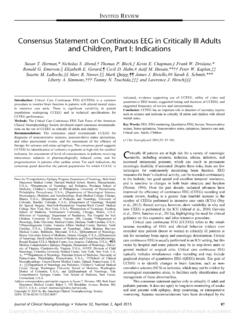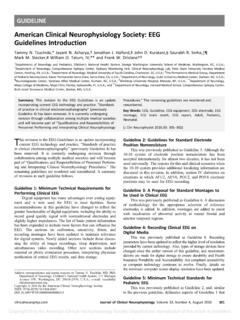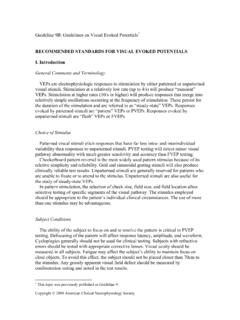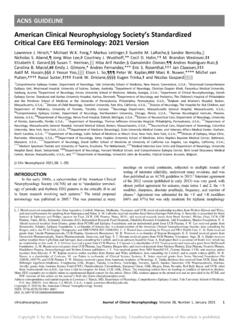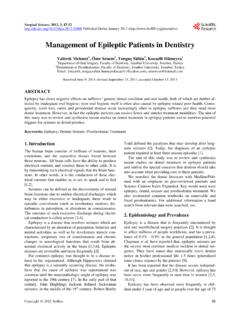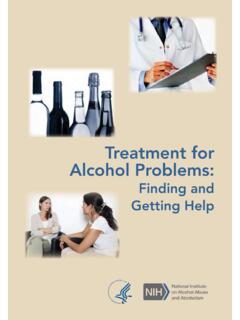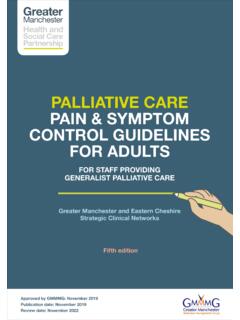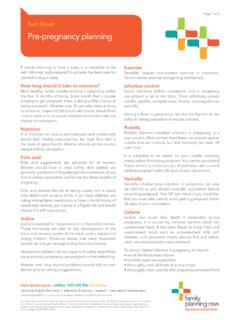Transcription of ACNS Standardized EEG Terminology and Categorization for ...
1 ACNS Standardized EEG Terminology and Categorization for the Description of Continuous EEG Monitoring in Neonates Report of the American Clinical Neurophysiology Society Critical Care Monitoring Committee Tammy N. Tsuchida*, Courtney J. Wusthoff*, Ren e A. Shellhaas, Nicholas S. Abend, Cecil D. Hahn, Joseph E. Sullivan, Sylvie Nguyen, Steven Weinstein, Mark S. Scher, James J. Riviello, Robert R. Clancy Tammy N. Tsuchida, MD, PhD. Assistant Clinical Professor of Neurology and Pediatrics Children's National Medical Center George Washington University School of Medicine Courtney J.
2 Wusthoff, MD. Assistant Professor of Child Neurology Stanford University School of Medicine Lucile Packard Children's Hospital Ren e A. Shellhaas, MD, MS. Clinical Assistant Professor Pediatrics & Communicable Diseases University of Michigan, Ann Arbor, MI. Nicholas S. Abend, MD. Assistant Professor of Neurology and Pediatrics Division of Neurology, The Children's Hospital of Philadelphia Departments of Neurology and Pediatrics, The University of Pennsylvania School of Medicine Cecil D. Hahn, MD, MPH. Division of Neurology, The Hospital for Sick Children Assistant Professor of Paediatrics (Neurology), University of Toronto Associate Scientist, The Hospital for Sick Children Research Institute Joseph E.
3 Sullivan, MD. Assistant Professor of Neurology & Pediatrics Director, UC San Francisco Pediatric Epilepsy Center University of California San Francisco Sylvie Nguyen The Tich, MD, PhD. Professor of Pediatrics Child Neurology Unit Laboratoire Ingenierie Systeme Automatises EA4094, LUNAM University Hospital ANGERS. Steven Weinstein, MD. Professor of Neurology and PediatricsChildren's National Medical Center George Washington University School of Medicine Mark S. Scher, MD. Professor of Pediatrics and Neurology Department of Pediatrics Division Chief, Pediatric Neurology Director, Rainbow Neurological Center, Neurological Institute of University Hospitals Director, Pediatric Neurointensive Care Program/Fetal Neurology Program Rainbow Babies and Children's Hospital University Hospitals Case Medical Center James J.
4 Riviello, MD. NYU Comprehensive Epilepsy Center NYU Langone Medical Center Director, Division of Pediatric Neurology Professor of Neurology Department of Neurology New York University School of Medicine Robert R. Clancy, MD. Professor of Neurology and Pediatrics The University of Pennsylvania School of Medicine The Children's Hospital of Philadelphia *These authors contributed equally to this manuscript. Background: Critically ill neonates are at high risk for adverse neurologic sequelae but the bedside evaluation of a neonate's neurologic status, especially cortical functioning, is extremely limited.
5 In such circumstances, continuous video EEG provides particularly useful information about brain function and can identify electroencephalographic seizures without clinical , 2 For these reasons, continuous video EEG monitoring is a useful tool in the intensive care nursery (ICN). The American Clinical Neurophysiology Society (ACNS) has recently produced guidelines regarding methods and indications for continuous EEG monitoring in A challenge in EEG monitoring of neonates is to understand the clinical significance of various EEG patterns. In the adult ICU population, there has been extensive debate, for example, regarding the importance of fluctuating rhythmic The ACNS Critical Care Monitoring Committee has generated Standardized Terminology of rhythmic EEG patterns in the critically ill in order to facilitate multicenter collaborations to determine whether these patterns have clinical Neonates have distinctive EEG patterns that necessitate separate Terminology .
6 This document is the consensus of experts to establish Standardized neonatal EEG. nomenclature aimed at improving consistency and facilitating collaborative research. Where evidence exists to support a particular definition, it is noted. For terms with historically variable definitions, alternative nomenclature is referenced but a single definition is proposed. We anticipate that future revisions will incorporate feedback and emerging research building upon this initial effort. Many of the studies upon which these criteria are based utilized routine-length EEG recordings and in this limited context, values such as acceptable duration of interburst intervals have been offered.
7 However, greater variability may be expected in recordings of longer duration. Our hope is that this document provides groundwork for collaboration to determine the clinical significance of various EEG patterns in continuous monitoring of the critically ill neonate. DETAILS TO BE REPORTED. Characterization of a 24 hour period of continuous video EEG recording should include: (Box 1). 1. Documentation of patient's postmenstrual age (PMA= gestational age, measured from the time of the last menstrual period + chronological age) at the time of a) Term = 37 up to 44 weeks PMA.
8 B) Preterm = less than 37 weeks PMA. c) Post term = 44 to 48 weeks PMA. 2. Documentation of neuroactive medications at the time of recording. This includes sedatives, hypnotics, anxiolytics, general anesthesia, and anti - epileptic drugs. An a We use the term PMA here in accordance with the American Academy of Pediatrics policy statement on age Terminology in the perinatal period. However, we recognize that historically, many seminal investigations of EEG ontogeny calculated gestational age from the time of conception rather than the last menstrual period. This has been traditionally termed conceptional age (CA).
9 The LMP occurs about 2 weeks before conception. ideal report would also document when these medications are administered during the recording. 3. Documentation of the depth and duration of hypothermia during the recording, and whether it is spontaneous or induced. 4. An ideal report would also document clinical changes that have the potential to impact cerebral function. These would include sudden hemodynamic instability, rapid changes in respiratory function or cardiorespiratory failure. 5. Documentation of the number of hours of recording that cannot be interpreted due to technical problems.
10 6. Detailed characterization of the background EEG features during the first hour of recording. Presence or absence of state changes must be included. 7. Characterization of one hour of background recording within each 24 hour period of EEG monitoring. 8. Characterization of additional epochs of background when there are relevant changes. Relevant changes include not only evidence for increasing encephalopathy but also the new development of episodic state changes. 9. Documentation of seizure onset, seizure burden, and seizure resolution. When present, specific note should also be made of the beginning and end of status epilepticus.

